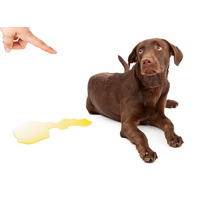Toilet Training a Puppy - Step by Step Guide
Date Posted:19 July 2017

You have just bought home your gorgeous new puppy and everyone is excited. The pup is finally settling at night and not crying, first mission accomplished. Now your next goal is getting the dog toilet trained, because no one enjoys mopping up wee.

You have just bought home your gorgeous new puppy and everyone is excited. The pup is finally settling at night and not crying, first mission accomplished. Now your next goal is getting the dog toilet trained, because no one enjoys mopping up wee. So let's talk about how you can go about toilet training your dog (some people might call it "house breaking", by the way).
Before we go to the details, let's answer a few common questions
When can I start toilet training my dog?
There is no definite answer for this. Generally speaking, puppies start to develop effective bladder control between 12-16 weeks. There is no point to force toilet training on a dog without sufficient bladder control. If you are buying from a breeder, usually the breeder will be able to tell you where the pup is at with toilet training.
My dog is going to be an outdoor dog (i.e. it sleeps outside in a dog kennel), do I need toilet training?
While it is not as important to toilet train a dog that stays mostly outside (compared to an indoor dog), there are still obvious advantages to toilet training. For example, it would not be very nice to open the back door and find a pile of dog poo right in front of your door steps, right? Nor have your dog randomly peeing and leaving droppings all over the place. It would be much easier if your dog is always doing its business in a designated area. So we still recommend toilet training for outdoor dogs.
If I buy one of those fake grass dog toilet trays from the pet shops, my dog will automtaically go on it, right?
Unfortunately no. While some of the dog toilet kits may be scented to encourage dogs to "mark" them, that is rarely sufficient to replace toilet training. At the end, it is just a tool and it is up to you to train your dog where it needs to go.
Toilet Training Step-By-Step
Before we discuss the details, we would like to point out that there are physical limits to a dog’s ability to withhold their “outcomings”. So expecting your dog to hold it for 10 hours during the day, every day, is simply not possible. Generally puppies need to go once every 2-3 hours during the day, adult dogs can hold up to 4-5 hours. At night, dogs can generally hold much longer because they are not drinking or eating.
Depending on your situation, you can choose to train where you want your dog to do its business in the long run. It does not matter if you are training your dog to do it on grass, on a garden bed, on concrete or on a plastic tray, the method is the same. For example, if you live in an apartment and do not have a backyard, you can train your puppy to do it on a toilet tray from day 1.
Step 1: Preparation before your dog is physically ready
Like we have mentioned above, young puppies do not have enough bladder control so they cannot hold. Many people do not realise you can actually start toilet training right away, so your puppy will have a head start as soon as it has enough bladder control to hold. Most people like to get their puppies right before holidays and long breaks, because it allows them to spend more time with their puppies. You can take advantage of this period and start a good habit and reinforcing the behaviour. The goal is simple. Get your puppy to do its business on the designated toilet as many times as you can, and let your dog knows that it's a good thing to do it there. Dogs are creatures of habit, if you make it do something again and again, eventually it will self repeat.
- Most puppies need to relieve within 20min after eating and drinking, so this is a great opportunity to take your puppy to the designated toilet spot. After your puppy does it in the right spot, reward it with playtime and/or treats
- Learn the signs when your puppy wants to wee, usually it's sniffing at the floor, pacing, staring at your etc. Take your dog to the designated toilet spot when it happens
Just remember, you do not have to be there for every "business opportunity". The goal is just get the puppy to do it on the designated spot enough times to start a habit of it, you will definiely miss some here and there, so relax.
TIP: Do not punish your dog for having an accident (even in later stages). It takes time to toilet train, frightening your dog (through punishment) will encourage it to not pee in front of you which can hinder your toilet training. If you are not home, just limit the dog to a playpen setup on tiles or floorboard to easy cleaning. You can consider buying a piece of vinyl flooring from the hardware store (it's about $15-20 per sqm) to lay on the floor inside the playpen. They are super easy to clean because you can take the entire thing outside to hose, and has no gaps that can trap dirt.
Step 2: Forcing your dog to hold
We are basically doing the same thing in step 2, but just upping the ante a bit. We want to make sure the dog is doing it at the right spot many times in a row, to really reinforce the habit.
You are going to be a bit stricter since your dog now has enough bladder control to hold. By instinct, dogs do not like to soil themselves so they try not to defecate or urinate where they sleep or relax. So the idea is to keep your dog in a small enough space (i.e. a dog crate) so if it pees in there, it has to sit right on top of it. Naturally your puppy will try to hold.
- Find a dog crate (or any type of enclsoure) small enough so your dog cannot pee on one side and sit on the other side
- You need to be home for this, so you will need to dedicate at least 2-3 days to always have someone at home (e.g. a weekend or long weekend)
- Put your dog inside the crate and put the crate next to you guys so the dog doesn't feel left out. Set a timer and take your dog out to the designated toilet spot every 2 hours. Always reward it with playtime and/or treats after. Do not put your dog into the crate right after relieving, as that could cause your dog to think it's getting locked up for peeing in the designated area
- Put your dog back in and wait to the next timer
- Repeat again and again
By the end of the weekend, your puppy should have received a very clear message. It has been peeing in the same place agan and again for the last 10-15 times, and good things always happens after doing it there. Hopefully, this would be enough to kick start a routine for your dog that will repeat itself. If not, just go through this cycle again.
TIP: If your puppy has an accident in the crate, then maybe its bladder is not holding that well, so you may have to wait another week or two.
Step 3: Fine Tuning
Now, your dog is doing the right thing most of the time, but there are still accidents every once in a while, which is very frustrating. Sometimes you feel like you are moving 3 steps forward 2 steps back, and just can't seem to fully perfect it.
Unfortunately there are no magic tricks for this part. You just need to be persistant about it and not stress yourself out. Every dog is different so the exact same method can yeild great result on one dog and very slow result on another. Some stubborn dogs (e.g. some Jack Russells) simply require 6-9 months to perfect its toilet training. Just stick to your methods and keep reinforcing the good behaviour. Try your best to resist from punishing accidents, like we have said before, it often backfires.
If your dog suddenly start having accidents several days in a row, remember to check for urinal or bladder infections at the vets.

 Collapsible
Collapsible